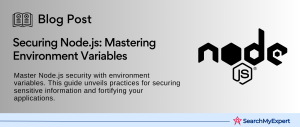Introduction to Microservices and Node.js
In today’s fast-paced digital world, the way we develop and deploy software has significantly evolved. The adoption of microservices architecture has become a cornerstone for enterprises looking to scale and adapt to changing market demands swiftly. This article will delve into the world of microservices, with a special focus on why Node.js has emerged as a popular choice for implementing this architectural style. We’ll explore the benefits and challenges of microservices architecture and identify common use cases for microservices in Node.js development.
What are Microservices?
Microservices architecture is a method of developing software systems that are divided into small, independently deployable services. Each service is scoped to a single business function and communicates with other services through well-defined APIs. This approach contrasts with the traditional monolithic architecture, where all functions are tightly integrated into a single service.
Benefits of Microservices Architecture
- Scalability:
Microservices can be scaled independently, allowing for more efficient use of resources and the ability to handle increased load on specific components of a system. - Flexibility:
Developers can use the most appropriate technology stack for each service, making it easier to incorporate new technologies and updates. - Resilience: The failure of one service does not necessarily bring down the entire system. This isolation increases the overall system’s fault tolerance.
- Faster Deployment:
Smaller, independent teams can manage microservices, enabling quicker updates and faster time-to-market for new features.
Challenges of Microservices Architecture
- Complexity in Management:
Managing multiple services, including their deployment, scaling, and monitoring, can be more complex than managing a monolithic application. - Data Consistency: Ensuring data consistency and managing transactions across services can be challenging.
- Network Latency: Increased communication between services over the network can lead to latency issues, impacting the user experience.
Why Node.js for Microservices?
Node.js has gained popularity for microservices development due to its lightweight nature and efficiency in handling asynchronous operations. Here’s why:
- Performance: Node.js’s non-blocking I/O model ensures high throughput and low latency, making it ideal for microservices that require high performance.
- Scalability: Its event-driven architecture supports horizontal scalability, essential for microservices that need to scale based on demand.
- Ecosystem: Node.js has a vast and active community, providing an extensive array of tools and libraries that simplify microservices development.
- Developer Productivity:
JavaScript (or TypeScript), used for Node.js development, is a widely known language, which can speed up development and reduce the learning curve for new developers.
Common Use Cases for Node.js Microservices
- Real-time Applications: Node.js excels in building real-time applications like chat apps or live notifications due to its efficient handling of I/O operations.
- API Gateways:
Implementing
API gateways to route requests to appropriate microservices, manage APIs, and aggregate responses. - IoT Applications: The scalability and performance of Node.js are well-suited for Internet of Things (IoT) applications, which require managing a large number of concurrent connections.
In conclusion, the microservices architecture offers a flexible, scalable, and resilient approach to developing complex software systems. Node.js, with its performance and scalability, stands out as a prime choice for implementing microservices. Despite the challenges, the benefits of microservices, especially when combined with the capabilities of Node.js, make this architectural style and technology stack a powerful tool in the arsenal of modern software development.
Planning and Design of Microservices with Node.js
When embarking on the journey of developing microservices, especially with Node.js, meticulous planning and design are paramount. This phase lays the groundwork for a system that is scalable, resilient, and capable of evolving over time. Let’s delve into the crucial aspects of planning and designing microservices, focusing on defining boundaries, selecting communication protocols, and ensuring scalability and fault tolerance.
Defining Boundaries and Responsibilities
The first step in designing a microservice architecture is to accurately define the boundaries and responsibilities of each microservice. This process, often referred to as domain-driven design (DDD), involves breaking down the system into distinct domains and subdomains, each representing a specific business capability.
- Identify Business Capabilities: Start by mapping out the core functionalities of your application. Each capability should ideally be encapsulated within its microservice.
- Bounded Contexts: Establish clear boundaries around each service, ensuring they are autonomous and can function independently. This separation minimizes dependencies and facilitates independent deployment and scaling.
Communication Protocols and APIs
Microservices need to communicate with each other to form a cohesive system. Choosing the right communication protocols and API styles is crucial for the efficiency and maintainability of your microservices architecture.
- RESTful APIs: Representational State Transfer (REST) is widely used for its simplicity and compatibility with HTTP/HTTPS. It’s ideal for public-facing services and where caching of responses is beneficial.
- gRPC:
Google’s Remote Procedure Call (gRPC) framework uses HTTP/2, enabling more efficient communication and supporting streaming data. It’s particularly suited for internal service communication and high-performance requirements. - GraphQL:
Allows clients to request only the data they need, reducing bandwidth usage and improving performance. It’s useful for complex systems with many entities and relationships.
Design for Scalability
Scalability is a core tenet of microservices architecture, allowing your system to handle increased loads gracefully.
- Horizontal Scaling: Design services to be stateless where possible, enabling them to scale out across multiple nodes easily.
- Database Scaling:
Consider database scalability, using techniques like sharding or separate databases, to ensure that your data layer doesn’t become a bottleneck. - Caching:
Implement caching strategies to reduce database load and improve response times for frequently accessed data.
Fault Tolerance and Independent Deployment
Designing for fault tolerance ensures that the failure of one microservice doesn’t compromise the entire system.
- Circuit Breakers:
Implement circuit breakers to prevent a failing service from causing system-wide failure. - Health Checks:
Regular health checks and monitoring allow for the early detection of issues and automatic recovery mechanisms, such as restarting or rerouting traffic to healthy instances. - Deployment Strategies:
Use containerization (e.g., Docker) and orchestration tools (e.g., Kubernetes) to facilitate independent deployment and manage service lifecycle efficiently.
Setting Up the Development Environment for Node.js Microservices
Creating an efficient and productive development environment is crucial for the success of microservices projects. This environment encompasses everything from version control to continuous integration and delivery (CI/CD) pipelines, ensuring that your development process is streamlined and that your team can focus on building high-quality microservices. Let’s walk through the essential steps and tools required to set up an effective development environment for Node.js microservices.
Choose a Version Control System
- Git: The cornerstone of any modern development environment, Git, provides a robust framework for managing code changes, collaborating with team members, and maintaining a history of your project’s evolution. It supports distributed development and integrates seamlessly with various online repositories like GitHub, GitLab, and Bitbucket, offering cloud-based platforms for code sharing, review, and collaboration.
Select a Task Runner
Task runners automate repetitive tasks like minification, compilation, unit testing, linting, and more. For Node.js projects, two popular choices are:
- Gulp:
Known for its speed and efficiency, Gulp uses a code-over-configuration approach, allowing developers to write tasks using JavaScript. It’s highly customizable and supports a wide range of plugins for different tasks. - Grunt: Grunt is a configuration-over-code task runner, where tasks are defined in a JSON-like file. It’s been around longer than Gulp and has a vast ecosystem of plugins.
Define Testing Frameworks
Testing is a critical part of the development process, ensuring that your microservices are reliable and bug-free.
- Jest:
A delightful JavaScript Testing Framework with a focus on simplicity. It works out of the box for any React project and is widely adopted for its ease of use and zero-config setup for Node.js applications. - Mocha:
Another powerful testing framework for Node.js, Mocha is flexible and supports both Behavior-Driven Development (BDD) and Test-Driven Development (TDD). It’s often paired with assertion libraries like Chai or Should.js for a more comprehensive testing suite.
Set Up Continuous Integration and Continuous Delivery (CI/CD) Pipelines
CI/CD pipelines automate the process of integrating code changes, testing, and deploying them to production, ensuring that your microservices are always up to date and stable.
- Continuous Integration (CI): Tools like Jenkins, Travis CI, or GitHub Actions can be used to automate the testing and building of your code every time a team member commits changes to version control. This helps identify and fix integration errors quickly.
- Continuous Delivery (CD):
Extends CI by automatically deploying all code changes to a testing or staging environment. Tools like Jenkins, GitLab CI/CD, and CircleCI enable automated deployment, making it easier to release new changes to customers quickly and safely.
Building Individual Microservices with Node.js
Developing microservices involves more than just writing code. It requires a thoughtful approach to architecture, choosing the right tools, and implementing robust testing strategies to ensure reliability and performance. In this section, we’ll explore how to build individual microservices using Node.js, focusing on selecting frameworks, implementing service logic and APIs, and ensuring comprehensive testing.
Choosing a Node.js Framework
The Node.js ecosystem offers several frameworks that can accelerate the development of microservices by providing structured ways to organize your code, handle HTTP requests, and manage middleware. Here are a few popular choices:
- Express.js:
Renowned for its simplicity and minimalistic approach, Express.js is a flexible framework that allows for quick development of web applications and APIs. It has a vast ecosystem of middleware and plugins, making it a versatile choice for many projects. - Fastify: Designed with performance in mind, Fastify is a fast and low-overhead framework. It offers an efficient routing system and excellent support for JSON Schema, making it ideal for projects where speed is a critical factor.
- Koa:
Created by the same team behind Express, Koa aims to be a smaller, more expressive, and more robust foundation for web applications and APIs. It uses async functions, allowing you to ditch callbacks and greatly increase error-handling capabilities.
Implementing Service Logic, Data Access, and API Endpoints
Once you’ve selected your framework, the next step is to implement the core logic of your microservice, which includes data access and API endpoint creation.
- Service Logic: Focus on the business logic that your microservice is responsible for. This could involve processing data, performing calculations, or any other function specific to your application’s needs.
- Data Access:
Most microservices need to interact with a database. Choose a database that fits your service’s data model and access patterns. Node.js supports various databases, both SQL (like PostgreSQL, MySQL) and NoSQL (like MongoDB, Redis), through different libraries and ORM/ODM tools. - API Endpoints:
Define RESTful API endpoints or GraphQL queries/mutations that expose your service’s functionality. Use the routing capabilities of your chosen framework to map these endpoints to your service logic.
Writing Unit and Integration Tests for Each Microservice
Testing is critical to ensure that your microservices work as intended and can handle various edge cases and errors gracefully.
- Unit Tests: Write tests for individual functions and components within your service. These should test functionality in isolation, mocking external dependencies as needed. Libraries like Jest or Mocha and Chai are excellent for writing and running unit tests in Node.js environments.
- Integration Tests: These tests go a step further by testing the interactions between components or services. They ensure that your service logic, data access, and API endpoints work together seamlessly. Integration tests can also involve testing your service’s interactions with external services or databases.
Containerization and Orchestration of Node.js Microservices
Containerization and orchestration are critical components in the development and deployment of microservices. They provide a framework for managing the complexities associated with running multiple services, ensuring they are scalable, portable, and easy to deploy. This section will guide you through containerizing your Node.js microservices and managing them using orchestration tools.
Containerizing Microservices with Docker
Containerization involves encapsulating a microservice and its environment into a container that can run consistently across different computing environments. Docker is the most popular containerization platform, offering a straightforward way to package your microservices with all their dependencies.
- Create a Dockerfile:
For each microservice, you need to create a Dockerfile, which is a script containing instructions on how to build the Docker image for that service. It includes the base image, dependencies, environment variables, and the command to run the service. - Build Docker Images:
With the Dockerfile in place, use the Docker CLI to build an image for each microservice. This image can then be run as a container on any system with Docker installed.
Orchestration with Docker Compose and Kubernetes
Once your microservices are containerized, you need a way to manage, deploy, and scale these containers. This is where orchestration tools come into play.
- Docker Compose:
Ideal for development environments and smaller deployments, Docker Compose allows you to define and run multi-container Docker applications. You can use a YAML file to configure your application’s services, networks, and volumes, and then create and start all the services from your configuration with a single command. - Kubernetes: For larger, production-grade deployments, Kubernetes is the leading orchestration platform. It provides powerful features for deploying, scaling, and managing containerized applications across a cluster of machines. Kubernetes can handle service discovery, load balancing, secret management, and more, making it well-suited for complex microservices architectures.
Service Discovery and Registry
As your microservices architecture grows, services need to communicate with each other. Service discovery and a registry are essential for dynamically managing the network locations of service instances.
- Consul:
Consul is a service networking tool that provides service discovery, configuration, and segmentation functionality. It allows services to register themselves and to discover other services via a central registry. - Etcd: Etcd is a distributed key-value store that provides a reliable way to store data across a cluster of machines. It’s often used for service discovery in Kubernetes, where it stores configuration data, state, and metadata for all running containers.
Deployment and Monitoring of Node.js Microservices
Deploying and monitoring are crucial stages in the microservices lifecycle, ensuring your applications are not only running in the desired environment but also performing optimally. This section covers the selection of a deployment platform, the use of Infrastructure as Code (IaC) for automation, and the implementation of monitoring tools for your Node.js microservices.
Choosing a Deployment Platform
The choice of deployment platform largely depends on your project’s requirements, scale, and the specific features you need. Here are some popular options:
- AWS ECS (Elastic Container Service):
AWS ECS is a highly scalable, high-performance container orchestration service that supports Docker containers and allows you to easily run applications on a managed cluster of Amazon EC2 instances. - Azure ACI (Azure Container Instances): ACI offers the fastest and simplest way to run a container in Azure, without having to manage servers or adopt additional services. It’s ideal for scenarios that can benefit from per-second billing.
- Heroku:
A platform as a service (PaaS) that enables developers to build, run, and operate applications entirely in the cloud. Heroku is known for its simplicity and support for a wide range of programming languages and frameworks, including Node.js.
Utilizing Infrastructure as Code (IaC) Tools for Automated Deployment
IaC tools allow you to manage and provision your infrastructure through code, rather than through manual processes. This approach enables automated, consistent deployment processes, making it easier to deploy and scale your microservices.
- Terraform:
An open-source IaC tool that allows you to define your infrastructure in a high-level configuration language. Terraform can manage service providers as well as custom in-house solutions. - AWS CloudFormation:
A service that gives developers and businesses an easy way to create a collection of related AWS and third-party resources, and provision and manage them in an orderly and predictable fashion.
Setting Up Monitoring Tools
Monitoring is essential for understanding the performance and health of your microservices. It helps you detect and diagnose issues before they affect your users.
- Prometheus:
An open-source monitoring and alerting toolkit with a powerful query language and visualization features through integration with Grafana. Prometheus is designed for reliability and scalability, making it an excellent choice for microservices architectures. - Grafana:
A multi-platform open-source analytics and interactive visualization web application. It provides charts, graphs, and alerts for the web when connected to supported data sources, including Prometheus.
Security and Observability in Node.js Microservices
Ensuring the security and observability of microservices is paramount for maintaining the integrity and reliability of your application. This involves implementing robust authentication and authorization mechanisms, securing communication between services, and enabling comprehensive logging and tracing. Let’s explore how to enhance the security and observability of your Node.js microservices.
Implementing Authentication and Authorization Mechanisms
- JWT (JSON Web Tokens): JWTs are a popular method for implementing stateless authentication. They allow services to verify the identity of users and ensure that they have the permissions to perform certain actions. Implement JWT by incorporating libraries such as jsonwebtoken in Node.js.
- OAuth 2.0:
For more complex scenarios, especially when integrating with third-party services, OAuth 2.0 provides a robust framework for authorization. It enables apps to obtain limited access to user accounts on an HTTP service, such as Facebook, GitHub, or Google.
Securing Communication Between Microservices
- TLS/SSL Encryption:
Use TLS (Transport Layer Security) to encrypt data in transit between your microservices. This ensures that sensitive data, such as personal user information or payment details, is securely transmitted over the network. - API Gateways: Employing an API Gateway as a single entry point for your microservices architecture can help manage, authenticate, and monitor traffic. It can enforce SSL, manage CORS policies, and authenticate requests before they reach your services.
Enable Logging and Tracing
- Logging:
Effective logging practices allow you to record and store events that happen within your application. Use logging libraries like winston or bunyan in Node.js to log important information about operations, errors, and system behavior. - Tracing:
Distributed tracing is crucial in a microservices architecture to track a request’s path across services. Implement tracing using tools like Jaeger or Zipkin. These tools help in identifying bottlenecks, latency issues, and the root cause of errors in complex distributed systems.
Implementing Observability
Observability goes beyond monitoring; it’s about gaining insights into how your application is performing and how users are interacting with it in real-time.
- Metrics:
Collect metrics on the performance of your microservices, such as response times, error rates, and system throughput. Prometheus can be configured to collect and store these metrics. - Dashboards: Use Grafana to create dashboards that visualize the collected metrics. This enables you to observe the health and performance of your services at a glance.
- Alerting: Configure alerts based on predefined thresholds for your metrics. This ensures that you are promptly notified of potential issues before they impact users.
Conclusion
Building microservices with Node.js is a journey that encompasses design, development, deployment, and continuous improvement. Throughout this guide, we’ve explored the critical steps necessary to create scalable, resilient, and secure microservices, from the initial planning and design phase to deployment, security, and observability. By choosing the right frameworks and tools, such as Express, Docker, Kubernetes, Prometheus, and Grafana, and by implementing best practices for security and monitoring, developers can build microservices architectures that are not only performant but also manageable and secure.
Unlock powerful server-side solutions with our Node JS Development Service.
Table of Contents
Toggle






